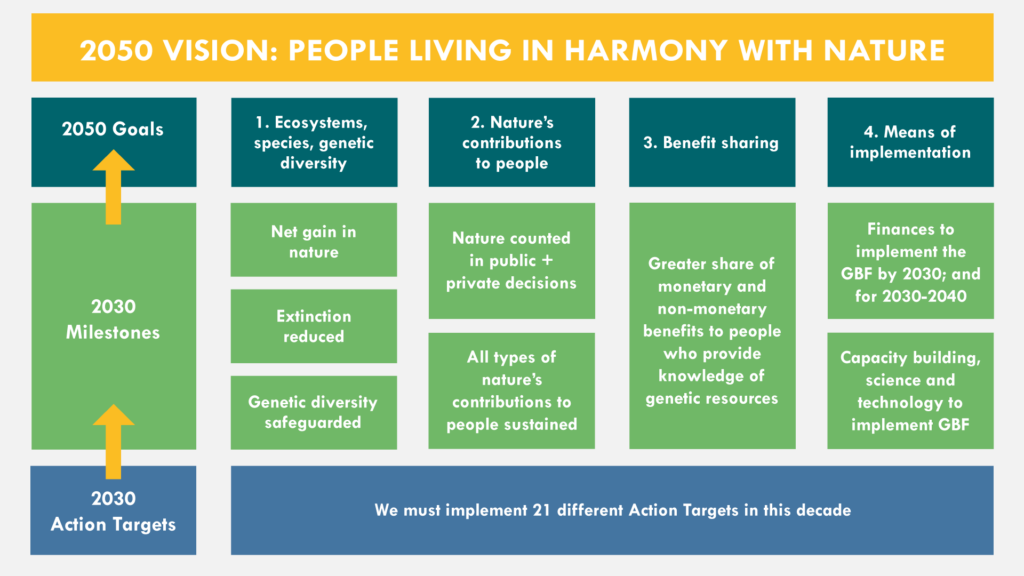Global goals and targets
The CitiesWithNature Action Platform is the place for cities to show what actions they are taking locally to help achieve global nature goals, today and by 2030. The mechanism through which these global goals are set is the Convention on Biological Diversity of the United Nations (CBD).
This Action Platform is based on the Global Biodiversity Framework, which is decided on by all 193 countries that are part of the CBD in 2022 at their fifteenth meeting, known as COP15.
The Global Biodiversity Framework is humanity's blueprint for living in harmony with nature:
The 2050 Vision is that humanity lives in harmony with nature, in a world where:
By 2050, biodiversity is valued, conserved, restored and wisely used, maintaining ecosystem services, sustaining a healthy planet and delivering benefits essential for all people.
To achieve this vision, the 2030 Mission is:
To take urgent action across society to put biodiversity on a path to recovery by 2030 for the benefit of planet and people.
This 2030 Mission will be achieved if the world takes action to meet the 2030 Milestones and various 2030 Action Targets, such as:
Target 12: Increase the area of, access to, and benefits from green and blue spaces, for human health and well-being in urban areas and other densely populated areas.
Target 14: Fully integrate biodiversity values into policies, regulations, planning, development processes, poverty reduction strategies, accounts, and assessments of environmental impacts at all levels of government and across all sectors of the economy, ensuring that all activities and financial flows are aligned with biodiversity values.

The CitiesWithNature Action Platform is based on the 2030 Action Targets of the CBD, and also shows how the nature actions of cities contribute to the achievement of the Sustainable Development Goals, in particular the SDGs most focused on nature and cities.
The Sustainable Development Goals (SDGs) and 2030 Action Targets are mutually dependent: Progress towards achieving the SDGs will support the implementation of the GBF, which in turn will contribute to the 2030 Agenda for Sustainable Development. This interdependency is recognized in Goal B of the GBF, which states "Nature’s contributions to people are valued, maintained or enhanced through conservation and sustainable use supporting the global development agenda for the benefit of all". One of the milestones under Goal B makes this linkage clear: "The long-term sustainability of all categories of nature’s contributions to people is ensured, with those currently in decline restored, contributing to each of the relevant Sustainable Development Goals."
How do cities align with national goals and targets?
The CitiesWithNature Action Platform helps cities gather information on how they contribute to their countries’ National Biodiversity Strategies and Action Plans, and can support national reporting to the UN Convention on Biological Diversity (CBD). The National Biodiversity Strategy and Action Plans (NBSAPs) are the principal instrument used by national governments for implementing the CBD. Local governments develop Local Biodiversity Strategy and Action Plans (LBSAPs), which feed into the NBSAP of their country. The Local Biodiversity Strategy and Action Plan (LBSAP) Guidelines is a document that guides local governments in detailing a broad strategy, as well as specific actions to implement in order to protect and enhance local biodiversity. Download it here.